Furthermore, all the suit cards are designed in a rather glamorous, almost whimsical fashion,
suggesting that this tarot too, as the aforesaid one of Geofrey Catelin, was a fancy edition,
with non-traditional illustrations yet based on the same themes found in standard packs.
Curiously, in the 16th century fancy
tarots were not at all uncommon. But this was probably due to
the lack of a consolidated tradition by any playing card pattern; we could
even say that the same concept of "pattern" as a fixed scheme was still under
development.
The woodblock engravings of the
Tarot de Paris, which in the finished deck
cannot be fully enjoyed due to a hasty stencil colouring that covers many small details, are certainly not those of
a luxury edition, i.e. a deck with hand-painted illuminations and additional details in silver and gold, whose only
specimen would have been presented to a local lord.
There is not even a subject nor a detail that may suggest a commemorative
purpose, to celebrate an important event.
Nevertheless, we may assume that the maker,
whoever he was (see below), hired a good artist for making what we would now call a
"special deck", an eye-catching novelty, maybe printed in limited edition; the unusual
attitude of some courts, as well as the peculiar arrangement and decorations of the pips
seem consistent with this hypothesis.
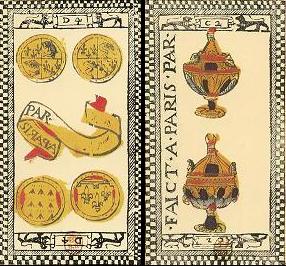
two subjects that should have mentioned the maker's name |
The cards of the replica, which the pictures shown in this page
were scanned from, maintained the original chequered frame, actually the flap
of the lining on the back, which was originally folded on the front and glued to the rim, a feature
common in Italian tarots and minchiate of the same age.
The author of the Tarot de Paris remains unknown. Curiously, the subjects that should have stated his
name, i.e. the 2 and 4 of Coins, and the 3 and 4 of Cups, bear an incomplete reference
that reads ·FAICT·A·PARIS·PAR· ("made in Paris by"). The name of the
maker is clearly missing from the empty spaces reserved for it, i.e. not obliterated nor rubbed off,
as if whoever printed the deck had in mind to add his name later on, rather than to omit
it: this is suggested by the last word ·PAR· ("by"). |
THE NAMES OF THE TRUMPS
The trumps bear their names in French, though their spelling
is somewhat more uncertain than in any other early edition, e.g.
LE PANDUT for
LE PENDU,
LA TREMPANCE for
LA TEMPERANCE, and so on (see also
the Tarot of Marseille part 1 for a comparison).
I · LE BATELEUR
the trivial performer |
VIII · JUSTTICE
justice |
XV · LE DIABLE
the devil |
II · LA PAPESSE
the popess |
VIIII · LERMITE
the hermit |
XVI · LA FOULDRE
lightning |
III · LINPERATRICE
the empress |
X · LA ROUE DE FOURTUNE
the wheel of fortune |
XVII · LESTOILLE
the star |
IIII · LANPERREUT
the emperor |
XI · FORCE
strength |
XVIII · LA LUNE
the moon |
V · LE PAPE
the pope |
XII · LE PANDUT
the hanged man |
XVIIII · LE SOLEIL
the sun |
VI · LAMOUREUS
the lovers |
XIII · LA MORT
death |
XX · LE JUGEMENT
judgement
|
VII · LE CHARIOT
the chariot |
XIIII · A TREMPANCE
temperance |
XXI · LE MONDE
the world |
|
LE FOUS
the fool |
|
Skimming through the 22 subjects, the first impression is that
this series is not really too far from the traditional pattern of Marseille, but it is
in the second half of the set that the trumps of the Tarot de Paris reveal most of
their differences. The farther each subject shifts from Marseille's scheme, the closer it
moves towards the north-eastern Italian one, particularly the old tarots from Ferrara;
interestingly, in Italy a similar blend between the tarot of Lombardy (i.e. Marseille's
ancestor) and any other variety was never reported.
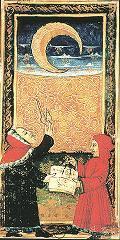
the Moon from the
tarot of Charles VI |
The aforesaid relation is probably explained by the tarot of Charles VI, still
belonging to the early tradition of hand-painted cards specifically made for important clients. According to an obsolete theory,
this deck, only a few subjects of which are now left, was made for the king of France who reigned
from 1380 to 1422, remembered for his madness more than for his feats. But most experts now
agree that these cards likely date back from the following century (late 1400s), and that
they were probably made in northern-eastern Italy, although they are now kept in the National
Library in Paris. The tarot of Charles VI is consistent with
others related to Ferrara and its surroundings (Dummett's group B, or eastern group).
We may believe that the author of the Tarot de Paris was likely aware of the tarot
of Charles VI, which may have represented an archtype in the
area of Paris.
|
THE SUBJECTS OF THE TRUMPS
In the Tarot de Paris the subjects face directions opposite to those belonging to
Marseille's pattern. This feature is discussed more in depth in the gallery about
Viéville's tarot.
The first trump features a performer of tricks, watched by other figures,
i.e. by his public, whose caricatural faces remark the triviality of man's material
activities, confirmed by a dog and a small monkey playing beneath the table.
Additional human figures are a detail never found in any other tarot
belonging to the Marseille group, whereas they are constantly present in Bologna's Tarocchino,
as well as in the luxury packs made between Ferrara and Venice (see
regional tarots).
|
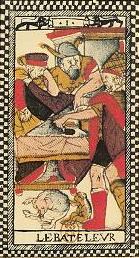
the Trivial Performer |
The Empress and
the Emperor
are both portrayed in a standing attitude, whereas normally they are sitting.
Furthermore, the female figure lacks the usual insignia (black stylized eagle on a
yellow background, crest of the king of Germany and emperor of the Western Roman Empire)
whose presence had been constant since the
Visconti tarots;
the Emperor, instead, wears a full coat of armour, and is somewhat reminiscent
of a suit card king.
The Lovers card is similar to Marseille's pattern, but
the elder figure that usually accompanies the couple is missing.
In
the Chariot we see a curious detail: the vehicle is not drawn by horses but
by geese; one of them is ridden by a child, despite the seated figure bears the typical
attributes of the triumphant roman general, i.e. a laurel crown and a sceptre.
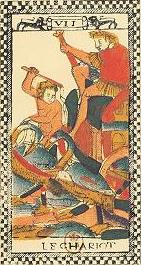
the Chariot drawn by geese |
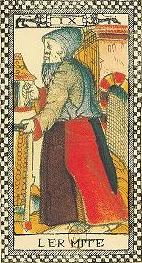
the Hermit before a doorway |
After a two-headed and blindfolded Justice with her traditional sword and scales,
comes the Hermit in a pilgrim-like attitude, featuring two minor yet unusual additions:
a rosary, held in one hand, and a building (a hospice or convent) whose doorway he stands in
front of; interestingly, still today in Bologna's tarot by the Hermit stands
a square column or pillar, whose shape is similar to this building.
Also the Wheel of Fortune, whose picture is shown at the bottom of the page,
is faithful to Marseille's tradition, although the
personages are four (one is kneeling below the wheel, as in the Pierpont-Morgan-Visconti
tarot) instead of the usual three, and do not have animal-shaped faces. |
Force and the Hanged Man without any noticeable
detail are followed by Death, whose only elements
of difference are the lack of severed heads of kings and popes scattered on the ground,
a heritage of the southern French tradition, and the presence of the subject's
name, LA MORT, which the same aforesaid tradition tended to
dropped, likely for superstitious reasons.
A standard Temperance precedes the Devil, whose design, instead, is clearly
not the one of Marseille: pictured sideways (not frontally), standing on the ground (without a pedestal), with
no minor demons tied by his sides, and an additional grotesque face on his belly,
all elements often found in the equivalent subject from Ferrara'a and Bologna's tarots.
The following card is probably the most interesting of the series: inscribed
LA FOVLDRE (for la Foudre, "lightning"), it is a subject that
the Tarot de Paris pattern retained from earlier tarots in place of the Tower or la Maison Dieu.
Burning thunderbolts or balls of fire fall from the sky (see also this subject in
Vieville's edition),
and while humans desperately seek shelter, a demon, the central figure of the composition,
dramatically remarks the rage of the heavens with the thundering sound of his
drum. |
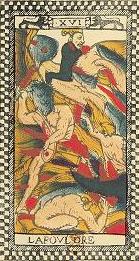
Lightning (i.e. the Tower) |
Among the cosmological subjects,
the Star trump is in line
with the scheme discussed more in depth in
Viéville's edition,
as it features an astronomer with his compass, but the following two certainly represent a
digression from the usual themes.
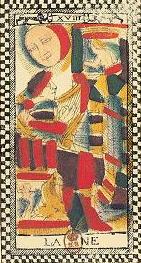
the Moon |
In the Moon, a serenade is in progress below the
window of a damsel, for whom a gentleman is playing a small harp. This interpretation rejects
any reference to hermetic symbolism (the lobster, the dogs, etc.), and almost foresees the genre scenes found in
the modern French-suited tarot.
Illustrations such as the one shown on the right, from a 15th century edition of the Roman de Paris,
(one among the many French romances written in the late Middle Ages, but still popular in the
1500s), could have easily been a source of inspiration for this subject. |
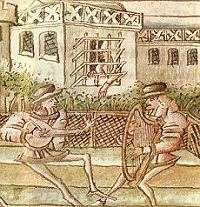
book illustrations such as this one
may have inspired the Moon's subject |
In
the Sun, instead, a woman looks in astonishment
towards a monkey holding a hand-mirror, that sits besides her.
The monkey with a mirror is a detail also found later on in the
Minchiate pattern; therefore, we may
think of this as a well-known allegory among card players.
A rather normal Judgment is followed by the World, another subject that
represents an element of connection to Ferrara's tarot.
But in this case the archangel
was replaced with a female figure; she holds a curtain with both hands, while balancing on a
globe blown by cherubs; the globe is shaped as the one that old monarchs used to carry as a
sign of power, i.e. topped by a cross.
Furthermore, still today in Bologna's Tarocchino a similar personage stands
upon a globe, although his attributes were turned into those of god Mercury,
see regional tarots, part I.
Since this is the highest subject of the series, the curtain may represent the mythical threshold or
gateway that man should pass at the end of his moral progress towards purification,
to reach the highest level of spiritual perfection (according to the Renaissance view of the cosmos,
organized by progressive circles or levels, see Mantegna's tarot).
|
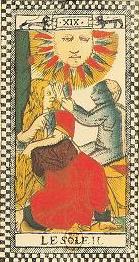
the Sun |
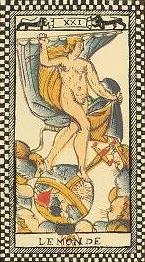
the World |
However, a rather similar representation, dated 1505, is found in Siena
(central Italy), in the city's cathedral, whose floor is covered
with marble-inlayed panels. One of them features a woman,
in this case the allegory of Fortune (on the right), balancing with one foot
on a sphere and with the other on a boat, and holding a sail above her; the
latter is quite reminiscent of the aforesaid curtain. In this allegory
Fortune actually represents man's fate, whose uncertain progress
is symbolized by the precarious steadiness of her standpoint.
Next to this panel is another one depicting a classic Wheel of Fortune;
this one is earlier, from the late 14th century, and although it was
completely replaced by a modern copy, made in the 1870s, due to the original's
bad condition, the image is still faithful to its early appearance.
Lastly, the Fool is not too special, but it curiously looks like a modern joker,
dressed as a typical jester.
|
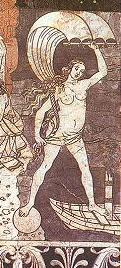
floor panel from the cathedral in Siena |
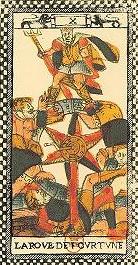

the Wheel of Fortune, and the relevant floor panel in Siena's cathedral
go to part 2
further reference to tarot decks can be found in Trionfi and in
The Hermitage
OTHER GALLERIES






















or back to

INTRODUCTION
AND HISTORY
|

MULTI-LANGUAGE
GLOSSARY |

THE FOOL &
THE JOKER |

INDEX
TABLE |

REGIONAL
GAMES |

PLAYING CARD
LINKS |